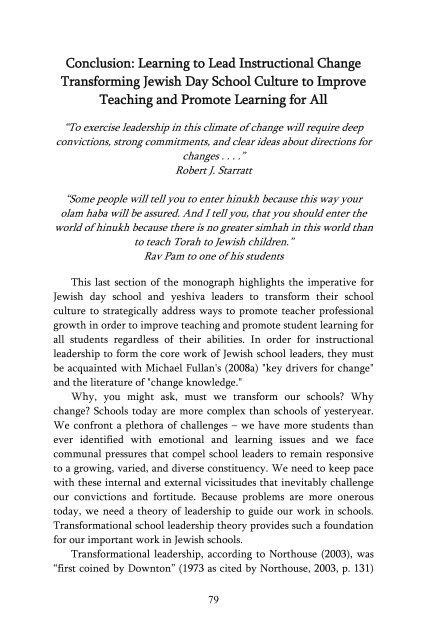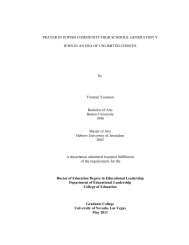Improving Instructional Quality in Jewish Day Schools and Yeshivot ...
Improving Instructional Quality in Jewish Day Schools and Yeshivot ...
Improving Instructional Quality in Jewish Day Schools and Yeshivot ...
Create successful ePaper yourself
Turn your PDF publications into a flip-book with our unique Google optimized e-Paper software.
Conclusion: Learn<strong>in</strong>g to Lead <strong>Instructional</strong> ChangeTransform<strong>in</strong>g <strong>Jewish</strong> <strong>Day</strong> School Culture to ImproveTeach<strong>in</strong>g <strong>and</strong> Promote Learn<strong>in</strong>g for All“To exercise leadership <strong>in</strong> this climate of change will require deepconvictions, strong commitments, <strong>and</strong> clear ideas about directions forchanges . . . .”Robert J. Starratt“Some people will tell you to enter h<strong>in</strong>ukh because this way yourolam haba will be assured. And I tell you, that you should enter theworld of h<strong>in</strong>ukh because there is no greater simhah <strong>in</strong> this world thanto teach Torah to <strong>Jewish</strong> children.”Rav Pam to one of his studentsThis last section of the monograph highlights the imperative for<strong>Jewish</strong> day school <strong>and</strong> yeshiva leaders to transform their schoolculture to strategically address ways to promote teacher professionalgrowth <strong>in</strong> order to improve teach<strong>in</strong>g <strong>and</strong> promote student learn<strong>in</strong>g forall students regardless of their abilities. In order for <strong>in</strong>structionalleadership to form the core work of <strong>Jewish</strong> school leaders, they mustbe acqua<strong>in</strong>ted with Michael Fullan's (2008a) "key drivers for change"<strong>and</strong> the literature of "change knowledge."Why, you might ask, must we transform our schools? Whychange? <strong>Schools</strong> today are more complex than schools of yesteryear.We confront a plethora of challenges – we have more students thanever identified with emotional <strong>and</strong> learn<strong>in</strong>g issues <strong>and</strong> we facecommunal pressures that compel school leaders to rema<strong>in</strong> responsiveto a grow<strong>in</strong>g, varied, <strong>and</strong> diverse constituency. We need to keep pacewith these <strong>in</strong>ternal <strong>and</strong> external vicissitudes that <strong>in</strong>evitably challengeour convictions <strong>and</strong> fortitude. Because problems are more oneroustoday, we need a theory of leadership to guide our work <strong>in</strong> schools.Transformational school leadership theory provides such a foundationfor our important work <strong>in</strong> <strong>Jewish</strong> schools.Transformational leadership, accord<strong>in</strong>g to Northouse (2003), was“first co<strong>in</strong>ed by Downton” (1973 as cited by Northouse, 2003, p. 131)79










